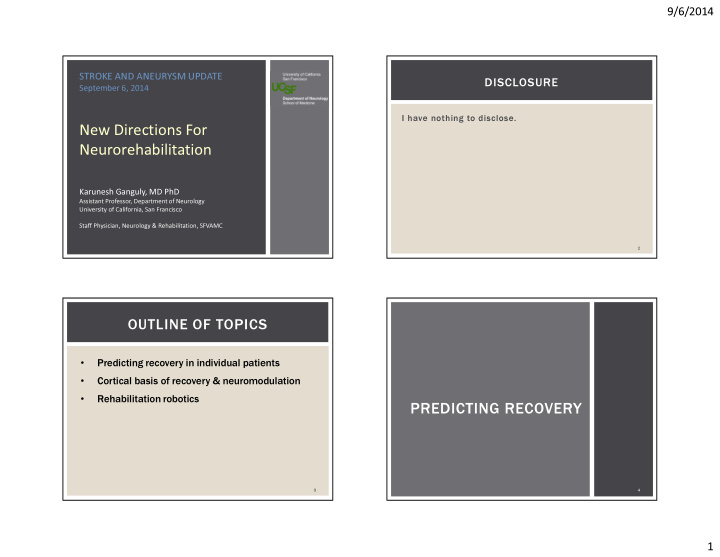



9/6/2014 STROKE AND ANEURYSM UPDATE DISCLOSURE September 6, 2014 I have nothing to disclose. New Directions For Neurorehabilitation Karunesh Ganguly, MD PhD Assistant Professor, Department of Neurology University of California, San Francisco Staff Physician, Neurology & Rehabilitation, SFVAMC 2 OUTLINE OF TOPICS • Predicting recovery in individual patients • Cortical basis of recovery & neuromodulation • Rehabilitation robotics PREDICTING RECOVERY 3 4 1
9/6/2014 POTENTIAL FOR RECOVERY TMS General characteristics at population level TMS • Age, infarct size & location, acute treatment regimen, medical co- EMG Recording morbidities TMS Exam findings • Independent digit movements, shoulder movements, ankle stimulus Amplitude (mV) 1 artifact dorsiflexion MEP Neurophysiological & Imaging • Transcranial magnetic stimulation � assess motor pathways • Neuroimaging � structural and diffusion weighted -1 MEP -10 0 50 What about predicting recovery for individual patients? Time (ms) • Multimodal assessment shows promise (exam, TMS, MRI) • Predicting Recovery Potential (PREP) algorithm (Stinear et al., TMS = Transcranial Magnetic Stimulation MEP = Motor Evoked Potential Brain, 2012) 5 6 MULTIMODAL ASSESSMENTS TO PREDICT RECOVERY MULTIMODAL ASSESSMENTS TO PREDICT RECOVERY SAFE Score ≥ 8, Complete recovery PREP Algorithm ARAT • • 40 patients with stoke Grasp (6) • (cortical & subcortical) < 8 Grip (4) • assessed at day 3 and Pinch (6) • reevaluated at 3 months Gross (3) TMS MEP +; Notable recovery • SAFE (Shoulder Abduction Items used… & Finger Extension) Score MEP Negative • TMS & MEP • DWI MRI (-); Limited MRI Diffusion Asymmetry Index (+); None Stinear et al., Brain 2012 Adapted from Stinear et al., Brain 2012 8 2
9/6/2014 NEURAL BASIS FOR RECOVERY ARM FUNCTION REPAIR MECHANISMS - Growth factors fMRI activity fMRI activity - GABA receptor - Angiogenesis Cortical basis for - Inflammation - Dendritic branching glial reaction glial reaction spontaneous recovery & - Axonal Sprouting - Cell-cycle proteins - Excitability Neuromodulation synaptogenesis synaptogenesis O Week 8 O Week 8 Ipsilesional Contralesional Hemisphere Hemisphere 9 Adapted from Cramer, Ann Neurol , 2008 IMBALANCE OF INHIBITION NON-INVASIVE NEUROMODULATION Imbalance of inter-hemispheric inhibition - - - - + + + + + + + + - - - - + + + + - - - - + + + + - - - - High-frequency Low-frequency (> 3Hz) rTMS (1 Hz) rTMS Rheme et al., 2011 Ward and Grefkes, 2013 11 12 3
9/6/2014 NEUROMODULATION WITH R-TMS META-ANALYSIS OF TMS TRIALS • 48 patients, randomized into 3 groups • Studies (n=18) Sham, 3Hz and 10 Hz rTMS of affected hemisphere • Small studies with ~10 patients from 2005-2012 • 5 days of stimulation at 130% of UH rest MEP • Rehab regimen? • Randomized but not blinded Khedr et al., 2010 • 1 Hz rTMS over the unaffected hemisphere (n=8) or HFS rTMS to affected hemisphere • Outcome measures were variable • Minimal adverse effects (HA, fatigue) • Subgroup analysis favored 1Hz rTMS over the Hsu et al., Stroke 2012 unaffected hemisphere 4=Moderate Severe; Dependent on ADLs; Unable to walk 13 1=No significant disability; Able to perform usual tasks NEUROANATOMICAL BASIS FOR TMS RESPONSE • 29 patients (16 subcortical, 13 cortical involvement) • Single dose of 10Hz (5s/25s for 20x over ~6 min) • 30% increase in speed of finger and hand taps for subcortical only REHABILITATION ROBOTICS Ameli et al., Ann Neurol, 2012 15 16 4
9/6/2014 UPPER-LIMB ROBOTICS UPPER LIMB ROBOTS AFTER STROKE • 128 patients � robotic, ICT, usual care Arm, hand, fingers • Moderate-severe (FGM ~20) • • 7 DOF in proximal Mean time from stroke � ~4 years • 19 DOF in the hand/fingers • Four modules: • Shoulder–elbow unit; an antigravity unit for vertical • >20 years of research into movements; wrist unit and a grasp unit rehabilitation robotics • 12 weeks of training consisted of four training • Based on research in motor blocks and were supervised by a therapist. learning and adaptation • Important clinical trials in the last • Training progressed from proximal (shoulder, few years wrist, hand grasp) Lo et al., NEJM 2010 • Final 3 week block, all three devices were used to integrate proximal to distal 17 18 Maciejasz, et al., 2014 ROBOTIC VS INTENSIVE VS ‘USUAL’ COMPLEX UPPER LIMB ROBOTICS • 7 DOF • Shoulder, elbow, wrist, hand open/close • Gaming environment for target movements, ADLs, ROM • Therapist can modify Lancet Neurology, 2014 19 20 5
9/6/2014 PATIENT POPULATION OUTCOMES 21 22 OUTCOMES CONCLUSION • Decades of basic research has built a foundation for evaluating and developing new treatments • Individualized predictive models and treatment plans seem quite feasible • Neuromodulation via stimulation is very promising • Rehabilitation robotics can offer a viable alternative. Cochrane Review (2012) Possible home-based rx? Patients who receive electromechanical and robot Rx are more likely to improve their generic activities of daily living but not arm muscle strength. 23 24 6
Recommend
More recommend